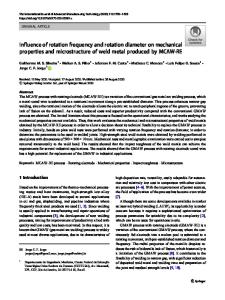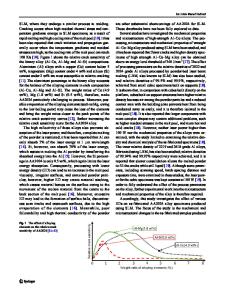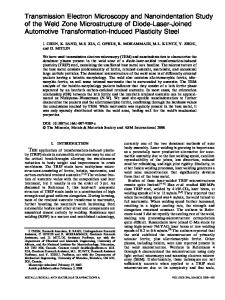Influence of Yb:YAG Laser Beam Parameters on Haynes 188 Weld Fusion Zone Microstructure and Mechanical Properties
- PDF / 7,631,904 Bytes
- 10 Pages / 593.972 x 792 pts Page_size
- 79 Downloads / 407 Views
ON
LASER welding, in particular with a CO2 source, has been widely developed for many applications, because of its many advantages, such as low heat input, small heat-affected zone (HAZ), low distortion rate, and high welding speed.[1–3] Welding of metals, such as superalloys, with a YAG laser beam has still not been adopted in industry due to thermal management issues leading to low-energy laser beams.[4,5] However, these technological problems have been solved with the emergence of new disk sources that achieve higher power levels of 9 kW with excellent optical quality.[6,7] These new sources present many other benefits: thin disk lasers provide a higher level of reliability; lower electrical power supplies are needed; and larger Rayleigh ranges are achieved.[8] Furthermore, Nd:YAG or Yb:YAG lasers can be delivered via optical fibers, opening up a large field of 3D applications of robotic cutting or welding. Different types of cracks and HAZ liquation can occur in weldments of superalloys: hot cracking,[9]
JE´RE´MIE GRANEIX, JEAN-DENIS BEGUIN, and TALAL MASRI are with the LGP/ENIT/INPT, Universite´ de Toulouse, 47 av. d’Azereix, BP1629, 65016 Tarbes Cedex, France, Contact e-mail: [email protected] JOE¨L ALEXIS is with the LGP/ENIT/ INPT, Universite´ de Toulouse, and also with the Laboratoire Ge´nie de Production, Ecole Nationale d’Inge´nieurs de Tarbes, 47 avenue d’Azereix, BP1629, 65016 Tarbes Cedex, France. Manuscript submitted December 13, 2016. METALLURGICAL AND MATERIALS TRANSACTIONS B
liquation cracking,[10] and cracking after annealing treatment. To improve their weldability, superalloys must have a small grain microstructure[11] and not be pre-weld heat treated,[12] and their total content of aluminum and titanium must be less than 6 wt pct.[13] A small number of works on laser welding of Haynes 188 alloy have been published. Odabasi et al.[14] analyzed the geometries of CO2 laser welds as a function of the energy implementation. They showed that the width of the welds and more generally the fusion zone (FZ) volume increased with the amount of energy used. Yilbas et al.[15] demonstrated a fine dendritic structure at the center of the FZ, including a few marked HAZ. This result was also obtained by Caiazzo et al.[16] for dissimilar welding of Haynes 188—Inconel 718 by a laser process. They estimated the thickness of the HAZ to be approximately 20 lm. Odabasi et al. observed by optical microscopy no HAZ or cracks at the interface of the base material (BM) with the FZ, but noted a gradient in hardness between these two zones over several hundred microns. Electron probe micro analysis (EPMA) measurements performed by Makino et al.[17] showed that the FZ composition was identical to that of the BM after laser welding. There was thus no loss of chemical elements by spraying. Odabasi et al. calculated a partition coefficient, noted k, for the major chemical elements; this partition coefficient was close to 1. They also showed that the tendency to segregation was low in the CO2 welding of Haynes 188 alloy. Makino
Data Loading...











